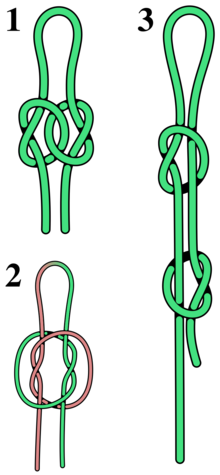True lover's knot
| True lover's knot | |
|---|---|
 Some knots often referred to as true lover's knots. the left one is also known as Dutch bend, the middle one is also known as Matthew Walker knot, the right one as Fisherman's knot. | |
| Names | True lover's knot, True Love Knot, love-knot, Fisherman's knot, Middleman's knot,[1] Shamrock knot[1] |
| Category | Bend |
| Category 2 | Loop |
| Related | Fisherman's knot, Matthew Walker's knot, Dutch bend |
| Typical use | symbolism, connecting two (or more, for Dutch bend) lines, lanyards, decorative |
| ABoK | #798, #1038, #1143, #1414, #2418, #2301, #2394, #2420, #2421, #2423, #2424, #2425, #2425, #2426 |
| Instructions | [1] |

The term true lover's knot, also called true love knot or simply love-knot amongst others, is used for many distinct knots. The association of knots with the symbolism of love, friendship and affection dates back to antiquity (although the term itself is attested from the late 1300s).[2] Because of this, no single knot can be labeled the true "true love knot".[3]
In practical terms, these knots are generally shown as two interlocked overhand knots made in two parallel ropes or cords. The variations are in the ways in which the overhand knots interweave and in the final arrangement of the knot or knots.[4]
The true lovers' knot is a motif in several British folk songs, including "Barbara Allen", "Lord Thomas and Fair Annet", "Lord Lovel", and "Fair Margaret and Sweet William". The knot, made of a rose growing from one lover's grave and a brier from the other's, is described at the end of the ballad.[5][6] It symbolises their fidelity in love even after death.[7]
Modern Western knotting literature has the name for these related knots deriving from stories or legends in which the knots symbolize the connection between a couple in love. Many examples feature sailors separated from their beloveds. Ashley notes that it was once a common style in sailors' wedding rings, where gold wire was wrought to incorporate the "true lovers" knot, creating a ring containing two tori, inseparable, yet flexible and able to move about each other.[4]
Examples in literature
- "A Love Knot"; a short story about Bengali Hindus featuring a goldsmithed love knot.[8]
- A “love-knotte” is mentioned in the prologue to the Canterbury Tales.
- In Sir Gawain and the Green Knight (line 612), Gawain's neck-support is embroidered with "trueloves"
- In The Highwayman, a poem by Alfred Noyes, Bess is “plaiting a dark red love-knot into her long black hair.”
See also

References
- ^ a b Scouting Resources, A-Z of Knots: S-T, retrieved 2009-06-14
- ^ Douglas Harper (2024). "Love-knot (n.)". Online Etymology Dictionary. Retrieved 2024-09-01.
- ^ van de Griend, P. (1996), "On the True Love Knot", in Turner, J.C.; van de Griend, P. (eds.), History and Science of Knots, K&E Series on Knots and Everything, vol. 11, Singapore: World Scientific Publishing, pp. 397–417, ISBN 981-02-2469-9
- ^ a b Ashley, Clifford W. (1944), The Ashley Book of Knots, New York: Doubleday, pp. 386–388
- ^ Coffin, Tristram P. (1950). The British Traditional Ballad in North America. Philadelphia: The American Folklore Society. pp. 76–9, 87–90.
- ^ "Versions and Variants of the Tunes of "Barbara Allen"" (PDF). Archived (PDF) from the original on 2022-10-09.
- ^ Würzbach, Natascha; Simone M. Salz (1995). Motif Index of the Child Corpus: The English and Scottish Popular Ballad. Gayna Walls (trans.). Berlin and New York: Walter de Gruyter. pp. 25, 57. ISBN 3-11-014290-2.
- ^ Theroux, Paul (1997). The Collected Stories. Penguin Group. pp. 164–176.
- ^ Burgess, Joseph Tom (1884). Knots, ties and splices; a handbook for seafarers, travellers, and all who use cordage; with historical, heraldic, and practical notes. London, George Routledge. p. 12.



